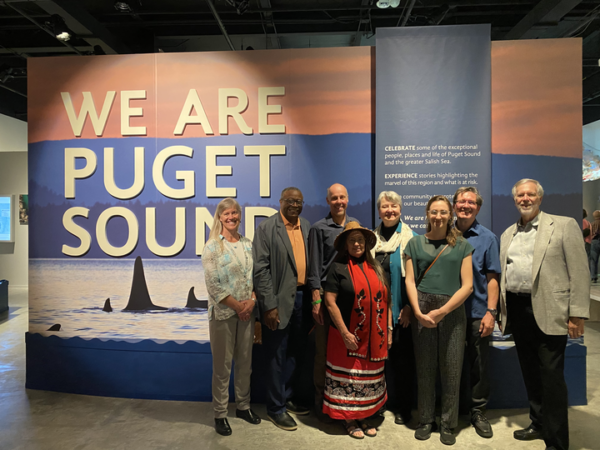 A big part of this story is how far the negotiators have come — six years ago, on farms outside Ellensburg the tension was palpable. The potential of a looming law suit was real. Yet, the desire to get to better place was felt by all. And over time the adversaries put down their guard, sat down to talk, and slowly built trust.
A big part of this story is how far the negotiators have come — six years ago, on farms outside Ellensburg the tension was palpable. The potential of a looming law suit was real. Yet, the desire to get to better place was felt by all. And over time the adversaries put down their guard, sat down to talk, and slowly built trust.
“It is with a mixture of relief and great pride that the Manastash Steering Committee will announce and sign an historic agreement,” said John Arum of Washington Environmental Council. “We hope it can serve as a model for successful resolution of water conflict throughout the state.”
The signing ceremony for the “Implementation Plan” and Memorandum of Agreement define fish screen, fish passage and instream flow improvements to Manastash Creek and as well as maintain the irrigation needs for local farming.
“I think it is great to finally be in a position to start working on restoring the Creek and providing fish passage and screening,” said Dave Duncan, Manastash Creek Irrigator.
“This agreement breaks down several barriers – people barriers as well as fish barriers,” said Tom Tebb, with the Washington Department of Ecology water resources program. “We were able to come together and see the greater vision for successful water management – a revitalized Manastash Creek and preservation of important water resources for Manastash water users.”
All members of the Manastash Steering Committee were in attendance including six Manastash Creek irrigators, John Arum (Washington Environmental Council), Tom Tebb (Department of Ecology), Jeff Tayer (Department of Fish & Wildlife), and Phil Rigdon (Yakama Nation). In addition, the following individuals were expected to attend: Director Jay Manning (Ecology); Jay Marcotte, Peter Lofy, Sandra Ackley and Marian Wolcott (Bonneville Power Administration); Dale Bambrick (NOAA Fisheries); William Boyum (Chair of Washington Conservation Commission); Commissioner Alan Crankovich (Kittitas County);and Mark Moore (Chair, Kittitas County Conservation District).
Background on Manastash Agreement
Six years after forming, the Manastash Creek Steering Committee has achieved a major milestone. On December 18, 2007, the Steering Committee will gather to officially approve the “Manastash Creek Restoration Project Instream Flow Enhancement Implementation Plan”. The Implementation Plan is the culmination of very intense work by Manastash Creek irrigators, state and federal agency staff and environmental interests to satisfactorily address instream flow in Manastash Creek.
The Implementation Plan is appended to a Memorandum of Agreement between the major irrigators on Manastash Creek, Bonneville Power Administration, Washington Department of Fish & Wildlife, Washington Environmental Council, and Kittitas County Conservation District. The MOA describes the plan to construct the fish screen facilities, achieve fish passage, and address instream flow. Principle concepts include the ownership of the facilities by Bonneville Power Administration, at least in the short term, and establishment of an operations and maintenance fund. The MOA is also planned for approval and signature on December 18, 2007.
The Implementation Plan is a 40-page document that proposes to improve in-stream flow conditions in Manastash Creek. Under current conditions, there is approximately a 3 mile reach of the stream that is dry from mid-June to November annually. The in-stream flow improvements are in two stages. The first stage is associated with consolidating three existing irrigation diversions in order to allow construction of three fish screen facilities instead of six. The consolidation involves moving those three points of diversions upstream. That move will be mitigated by an agreement to maintain 6 cubic feet per second (before pro-rationing) of in-stream flow.
The actions to improve instream flow will occur over several years as individual projects are developed and funding secured. The goal for this stage is not a specific volume of water in Manastash Creek, but a continuing reduction in the length of the reach that is dry annually and the time period in which it is dry in order to work toward the long term goal of perennial flow in lower Manastash Creek. Water saved through implementation of conservation practices will be protected through the Trust Water Rights Program.
Water acquisition and water conservation projects to achieve the 6 cfs goal will be implemented concurrent with or immediately after construction of the fish screen and fish passage facilities.
History
The Manastash Creek Restoration Project is being implemented by the Manastash Creek Steering Committee with assistance from the Kittitas County Conservation District (KCCD). The Manastash Steering Committee was formed in 2001 and consists of representatives of the Manastash Water Ditch Association (MWDA), individual irrigators from Keach Ditch, Jensen Ditch, Hatfield Ditch, Reed Ditch, Anderson Diversion and Barnes Road Diversion, as well as the Washington Department of Ecology, Washington Department of Fish & Wildlife, Washington Environmental Council, West Side Irrigating Company, Kittitas Reclamation District, US Bureau of Reclamation and the Yakama Nation.
The KCCD was engaged in 2003 to provide project management after the Washington State Legislature appropriated $2.24 million for construction of fish screens and fish passage at Manastash Creek diversions. In addition to those funds, the Bonneville Power Administration awarded $1.4 million to the Manastash Project through an application submitted by the Washington Department of Fish & Wildlife in 2002. Both of these funding sources were provided to construct fish screen and fish passage facilities.
In the years between 2003 and 2006, the strategy for providing fish screen and fish passage facilities underwent a number of changes. Initially, the Anderson, Reed, Hatfield, and Keach-Jensen diversions were to be moved to the MWDA diversion site. That plan was abandoned in 2005 and all diversions were to be screened at their current location. The consolidation plan was then modified and revived in early 2006. The current plan includes consolidating only the Reed Ditch, Anderson Diversion and Hatfield Ditch diversions to the MWDA diversion site. The Keach-Jensen diversion will be screened at its present location. In addition, the Barnes Road diversion will be screened at its present location.
In 2006, the KCCD worked with the water right owners on the Hatfield Ditch, Reed Ditch and Anderson diversions and Department of Ecology to complete applications to change their points of diversion to the MWDA diversion. Twenty eight applications were received by Ecology in August and September, 2006. Public notice of the change applications was published in the Ellensburg Daily Record on February 5, 2007 and February 12, 2007. Letters describing the proposed changes were sent by Ecology to each of the individual water right owners in early February 2006. No protests were received during the public comment period.
Also in 2006, at the direction of the Steering committee, the KCCD applied for a continuation of BPA funds ($1.5 million) to complete the fish screen and fish passage projects. KCCD also applied for additional BPA funds ($893,000) to begin addressing instream flow. BPA announced their FY07-09 Fish and Wildlife Project Selection Decision on their website on February 13, 2007. Both Manastash proposals were selected for funding.
Manastash Creek is a right bank tributary to the Yakima River at river mile 154.5. It drains a watershed of 97 square miles that cover elevations from 2,000 to 5,500 feet. The creek flows east from the foothills, through a narrow canyon until reaching a large, open plain that slopes toward the Yakima River. There are over 30 stream miles in the watershed. The Manastash Creek restoration project is focused on the lower 5 miles, where the majority of the irrigation diversions are located.
Manastash Creek is primarily snowmelt fed, with the largest flows occurring in spring and early summer. The hydrograph for Manastash Creek typically peaks in the months of March, April and May. It begins to descend between late April and late May to the point that not all water rights can be satisfied. The surface water rights from Manastash Creek are referred to by their “class” or priority date. The classes range from 1 to 18 with priority dates from 1871 to 1892. Typically, by early to mid June there is only enough water in Manastash Creek to meet the first and second class rights. As the hydrograph recedes, the water right holders of state based rights to Manastash Creek begin to regulate the diversions to meet the most senior rights first. All rights are reduced by 50% on July 1, however, natural conditions have already reduced the flow to the point where only Class 1 and a portion of the Class 2 water is available. Over sixty individual landowners hold water rights to divert irrigation water and stockwater from Manastash Creek. Those rights are spread across more than 4,000 acres.



